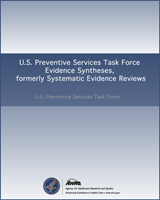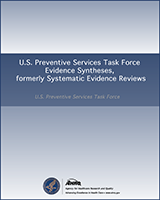NCBI Bookshelf. A service of the National Library of Medicine, National Institutes of Health.
Viswanathan M, Treiman KA, Doto JK, et al. Folic Acid Supplementation: An Evidence Review for the U.S. Preventive Services Task Force [Internet]. Rockville (MD): Agency for Healthcare Research and Quality (US); 2017 Jan. (Evidence Synthesis, No. 145.)
This publication is provided for historical reference only and the information may be out of date.

Folic Acid Supplementation: An Evidence Review for the U.S. Preventive Services Task Force [Internet].
Show details| Include | Exclude | |
|---|---|---|
| Populations | KQ 1: Women of childbearing age (postmenarchal and premenopausal; women with the potential for or planning childbearing) KQ 2: Women of childbearing age (postmenarchal and premenopausal; women with the potential for or planning childbearing); fetus, neonate, or child from index pregnancy | KQ 1: Prepubertal girls; men; women without the potential for childbearing (e.g., women who are postmenopausal or have genetic uterine or ovarian abnormalities) |
| Interventions | Folic acid supplementation, with or without food fortification or naturally occurring folate, for the prevention of neural tube defects and other birth defects Supplementation with micronutrients (e.g., multivitamins, iron) in combination with folic acid for the prevention of neural tube defects only | Food fortification only Naturally occurring folate only Counseling to improve dietary supplementation Supplementation with micronutrients (e.g., multivitamins, iron) in combination with folic acid for the prevention of harms only |
| Comparisons | KQs 1a, 1b, 2a: Placebo or no treatment; dietary supplementation only; supplementation with prenatal vitamins without folic acid; iron supplements without folic acid KQs 1b, 1c, 2b: All of the above plus folic acid supplementation of varying dosages | KQs 1a, 1b, 2a: Lower or higher doses of folic acid supplementation; folic acid vs. other active comparators KQs 1c, 2b: Folic acid vs. other active comparators (e.g., multivitamins) |
| Outcomes | Neonatal outcomes: Neural tube defects Harms from treatment: Twins Colorectal cancer or other reported types of cancer Vitamin B12 deficiency Vitamin B6 deficiency Other reported child, neonatal, fetal, or maternal harms | Benefits not specified in inclusion criteria |
| Timing | KQs 1a, 1b: Supplementation initiated before index pregnancy or in the first trimester KQs 1c, 2a, 2b: All timing | KQs 1a, 1b: Supplementation initiated after the first trimester of pregnancy |
| Settings | Developed countries categorized as “Very High” on the Human Development Index (as defined by the United Nations Development Programme) | Countries not categorized as “Very High” on the Human Development Index |
| Study designs | Efficacy (KQ 1): Randomized, controlled trials; controlled clinical trials; cohort or case-control studies Harms (KQ 2): Randomized, controlled trials; controlled clinical trials; or observational studies (case-control, cohort, registry data) | Commentaries, editorials, case reports |
| Sample size | More than 50 participants | 50 participants or less |
| Quality | Good and fair quality | Poor quality |
| Language | English | Non-English studies |
- Inclusion/Exclusion Criteria - Folic Acid SupplementationInclusion/Exclusion Criteria - Folic Acid Supplementation
Your browsing activity is empty.
Activity recording is turned off.
See more...
